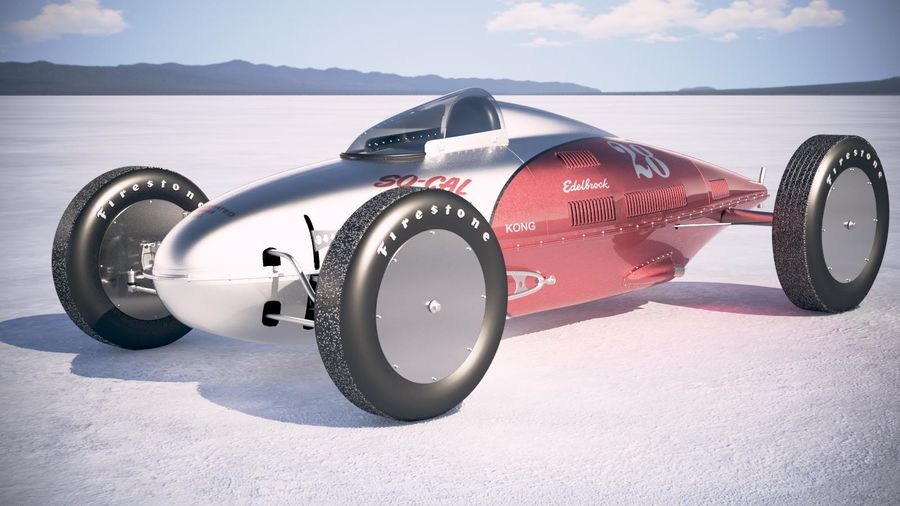1950 Belly Tank Bonneville Racer

The descriptions of the Classic Cars in the Directory were partly generated or supplemented with the help of artificial intelligence (AI). The content may occasionally not always be entirely accurate or factually correct despite careful checking.
The So Cal Belly Tank Bonneville Racer 1950 is an exceptional example of vintage race car engineering. This beautifully-designed vehicle has been built to perfection with a focus on both speed and performance.
Starting with the body, this racer is built on a highly aerodynamic fuel tank which has been carefully modified to provide the ultimate in downforce at high speeds. The tank is sleek and streamlined, with a highly polished finish that is sure to turn heads.
The engine that powers the So Cal Belly Tank Bonneville Racer 1950 is a highly-tuned V8 that is capable of producing a whopping 900 horsepower. This engine is mated to a custom-built transmission that delivers flawless shifting with incredible precision.
The suspension on this race car has been designed to handle the extreme forces that are generated at high speeds. With specially designed shock absorbers, the So Cal Belly Tank Bonneville Racer 1950 can take on the bumps and dips of the Bonneville Salt Flats with ease while maintaining stability and safety.
The wheels on this racer are purpose-built to handle the stresses of continuous high-speed driving. They are lightweight and constructed from highly-durable materials, making them resistant to the forces generated by high-speed racing.
Safety has also been a key consideration in the design of this beautiful machine. Special roll cages have been installed to protect the driver in the event of an accident, while a state-of-the-art braking system ensures that the So Cal Belly Tank Bonneville Racer 1950 can stop on a dime, even at high speeds.
Overall, the So Cal Belly Tank Bonneville Racer 1950 is a masterpiece of vintage racing technology. From the highly-tuned engine to the custom-built suspension and safety features, this racer is a testament to the ingenuity and craftsmanship of its designers and builders. Whether you're a speed enthusiast or a vintage car collector, this incredible machine is sure to captivate and inspire.
Milestones
- The creation of the So Cal Belly Tank Bonneville Racer began in 1950 when a group of hot rod enthusiasts from Southern California acquired a surplus World War II aircraft drop tank. - The tank was transformed into a high-speed racing machine, with modifications including a hand-built chassis, a blown and fuel-injected V8 engine, and streamlined bodywork. - The racer made its debut at the Bonneville Salt Flats in 1952, driven by hot rodding legend Alex Xydias, where it achieved a top speed of 198 mph. - Over the next few years, the So Cal Belly Tank Bonneville Racer underwent various modifications and improvements, including a new engine and upgraded suspension, resulting in multiple land speed records and a peak speed of 228 mph in 1957. - The racer was retired from competition in the mid-1960s but remained an iconic piece of hot rod history, inspiring generations of builders and racers. In the early 2000s, it was restored to its former glory by So Cal Speed Shop and can still be seen at automotive events and museums today.Technical
• The So Cal Belly Tank Bonneville Racer was a land speed racing motorcycle built in 1950.• The vehicle's body was made from a surplus World War II aircraft fuel tank, which is where the name "belly tank" originated.
• It was powered by a flathead V8 engine from a 1940 Ford car, which was modified to produce 200 horsepower.
• The racer used a number of additional custom parts, including a handmade exhaust system, a streamlined tail fin, and a custom suspension.
• The vehicle was designed to be as aerodynamic as possible, with a sleek, pointed front end and a smooth, rounded tail.
• It was painted bright orange with the "So Cal Speed Shop" logo painted on the sides.
• The So Cal Belly Tank Bonneville Racer set a number of land speed records in the early 1950s, including reaching speeds of up to 210 mph at the Bonneville Salt Flats.
• The car was later retired from racing and is now a museum piece, with a number of replica versions also produced over the years.